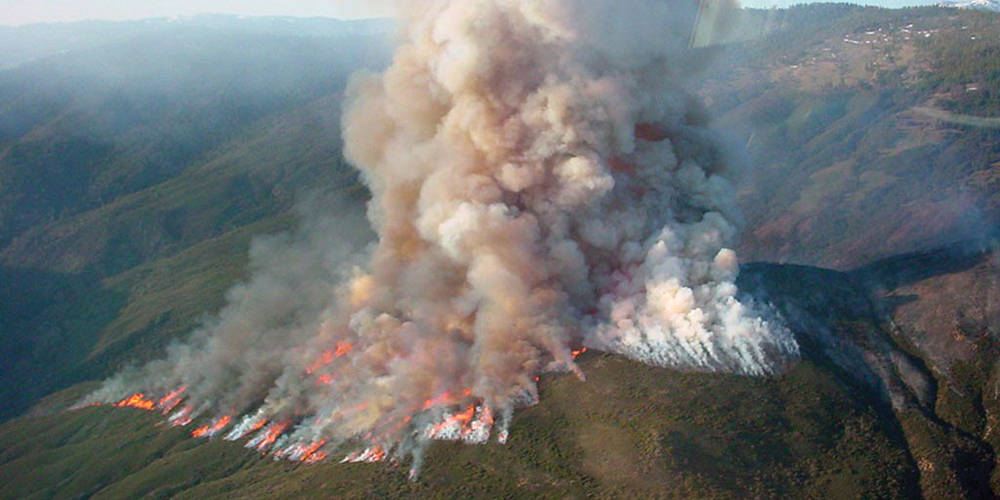As an individual, there is a lot you can do to be prepared for wildfire but what about our forests? Of course saving lives and protecting property is the priority and numerous community partners including Fire Safe Councils, CAL FIRE, and FEMA are working together to create a culture of community preparedness. But we also need to better prepare our forests though improved planning and management. Healthy forests provide numerous benefits including clean air and water, habitat for endangered and other species, recreational opportunities, renewable energy, wood products, and more. And despite the sophistication of our current fire suppression efforts, forest conditions are leading to fires that burn larger and hotter so that these benefits are being diminished.
Forest restoration and planning needs to occur at a much greater pace and scale. Fortunately there is a growing understanding that many of our forests are not healthy and that overgrown forests are susceptible to disease and intense wildfire. There is likewise broad consensus that science-based ecological restoration of our forests must be dramatically increased. In 2014, state and federal agencies and officials formally acknowledged the need for periodic fire to reduce hazardous fuels and protect humans and the environment from extreme fires, it led to the development of programs and initiatives focused on forest health and enhanced funding for forest management. This opened the door for SRWP to focus on fuels and fire management as a nexus to watershed health.
There an immense need and a strong desire to implement forest management efforts in the region including controlled burns, managed wildfire (within managed perimeters), mechanical thinning and pest treatments but we are underutilizing these tools. Primarily we need to shift to larger, landscape-level efforts to reduce wildfire risk and improve forest health. Forest restoration and management should be implemented comprehensively at the landscape-level to be effective and yield multiple watershed benefits. Implementing restoration efforts across the landscape increases the range of benefits achieved. A study by the USFS Fire Sciences laboratory found that implementing small, randomly placed fuel reduction treatments across 20% of the landscape had almost no effect on the spread rate of a large fire but implementing small but strategic treatments that complement one another across 20% of the landscape can halve the spread rate.
Large-scale planning and restoration efforts will require more collaboration among federal and state agencies, and with private landowners. Thanks to recent efforts by the USFS and Sierra Nevada Conservancy, there is a renewed awareness of the need for more efficient and larger landscape planning processes and increased support for the development of coordinated, integrated, collaborative efforts to improve forest health. As a result, we are working with stakeholders to develop cooperative, cross-boundary projects in the Sacramento River Watershed that are compatible with larger collaborative forest management efforts.
We have signed an MOU with the Butte County Fire Safe Council to work together to establish the foundation for the development and formalization of a Landscape-Level Planning effort in Butte County. The MOU represents our commitment to carry out several tasks including:
- developing a strategic planning process to support the prioritization, implementation and monitoring of forest health projects,
- creating education and outreach materials with targeted messaging to stakeholders, decision makers, and the public and;
- identifying and secure funding opportunities and resources to improve forest health.
By demonstrating and promoting successful collaboration at the county level, this effort will validate the model for work on the larger landscape and serve as a framework for other counties within the Sacramento River Watershed. This effort represents a tiny fraction of a landscape in need of major investment, but its implications are far reaching. Not only will these collaborative efforts improve forest health by restoring habitat and minimizing catastrophic fire, they will:
- Help to increase public awareness of the role forests play in protecting critical water supplies for humans and the environment.
- Build the connection between the landscape and management in upstream areas and downstream impacts in the valley and the Delta.
- Demonstrate and promote the role of fire as a natural and necessary element in fire adapted environments.
- Serve as a framework for communities to become more resilient to the impacts of drought and fire.
It took decades to create current forest conditions and it will take decades to improve forest health. There are proven techniques that can get the job done. We have tools to support more effective funding and collaboration. What we need now are champions at the local, state and federal levels to support these efforts. By developing the right partnerships and planning approach we should be successful in implementing unified and complimentary forest management goals. Our hope is that our collective efforts will launch a successful program to protect and restore our forested watersheds and strengthen the region’s resiliency for future generations.

